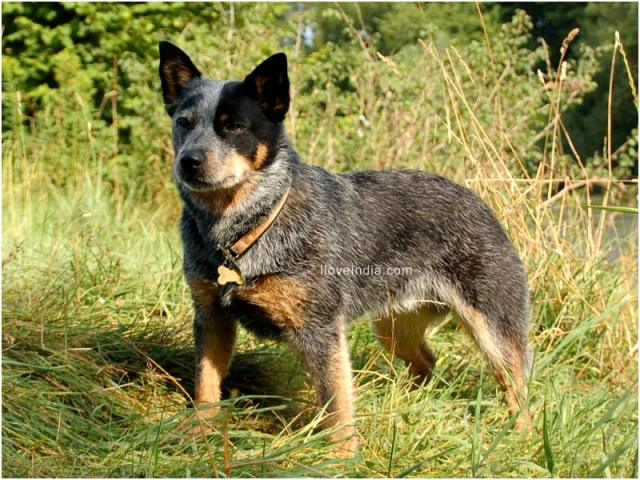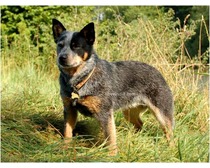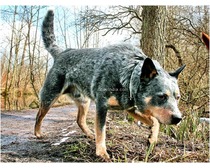Australian Cattle dogs are strong and muscular companion dogs, residing in the different zones of Australia. Read on to know more about the Australian Cattle dog breed.
Australian Cattle Dogs
Breed Type: Herding dog

Weight: Males - 16 to 23 kg (35 to 50 pounds); Females - 12 to 18 kg (25 to 50 pounds)
Height: Males - 46 to 51 cm (18 to 20 inches); Females - 43 to 48 cm (17 to 19 inches)
Coat Type: Double coat
Australian cattle dog is a herding or working breed, with very high energy levels. It was developed in Australia, for the purpose of herding livestock-like cattle. These dogs are sometimes also referred to as Red Heelers, Blue Heelers or the Queensland Heelers. Their powerful stature and strong muscled frame helps them enormously in their guarding activities. They are very cautious by nature and do not trust any stranger easily. However, they are very close to their owners, with whom they share a special bond. Australian cattle dogs have an average lifespan of about 11.7 years and may suffer from certain health conditions, like infertility, elbow dysplasia and arthritis in their lifetime. The breed is very popular worldwide and has even been used as companion in a number of movies, like Secret Window and Babe. To know more about this unique dog breed, go through the information given below.
History
The origin of Australian Cattle Dog can be traced back to the eighteenth century, when stockmen in Australia felt the need of a herding dog with great stamina, to bear the harsh conditions of the country. The native Smithfields and the old Smooth Collie dogs were unable to keep up their expectations and hence, the process of experimental breeding started. It all began with the crossing of the Smithfields with the wild Dingo, resulting in a breed Timmins Biters, which was quiet, but a little hard. This was followed by the breeding between the Dingo and a primitive stage of Collie, which was used for the purpose of mustering sheep during those days.
Dingo and Collie crossbreeding led to the production of a new dog breed called ‘Hall’s Heelers’, which was noted for its hardy, tireless and controllable nature. This breeding was carried out by Thomas Hall in the year 1840. It was in the year 1870 that Fred Davis bred some Bull Terrier into the Hall’s Heelers, to create a more aggressive breed that became very popular as sporting and guard dogs during the 19th and the 20th centuries. This species is very fearless with cattle and is known to nip their heels while mustering them, in order to keep them moving. Another breed that was used to create this unique class of dog was the Dalmatian.
Appearance
Two words that can beautifully and completely explain Australian cattle dog is sturdy and compact. The breed is very agile and swift, with a well-muscled frame. The dog has a broad and a slightly rounded head that tapers to a definite stop. It has medium-size oval eyes, with widely placed ears and a deeply placed muzzle. Its skull and muzzle are placed almost on parallel planes. The razor sharp teeth enable the dog to maintain the livestock, by biting their heels. Its neck is very strong, blending into a strong muscular body. Australian cattle dogs have deep chests, muscular loins and deep flanks. They also have very round feet, with short toes that lie close together and are well-arched. Their strong nails and deep footpads enable them to bear harsh conditions. They have a short dense undercoat, with a straight protective outercoat that is rain resistant.
Personality
Australian cattle dogs are amazing guard dogs, renowned for their strong, protective and alert nature. They are very loyal to their owners and once properly trained, can become your friend for life. However, these dogs are quite temperamental and fiercely protective of their property or owners. They can be quite stubborn at times and require firm, yet fair handling. Australian cattle dogs are also very reserved with strangers and do not mix that well with kids, unless they have been raised together from a very young age. They can be very suspicious of people and have very high levels of intelligence and astuteness. They are also very popular for their brave and trustworthy nature.
Genetic Disorders
One very common genetic disorder seen among Australian cattle dogs is Progressive Retinal Atrophy. This is an autosomal recessive condition, wherein the rods and cones in the retina of the eyes begin to deteriorate, leading to progressive blindness.
Grooming
Australian cattle dog needs very little grooming and coat maintenance. All you need to do is brush its double coat regularly, with a firm bristle brush and an occasional wash. Make sure to use a good quality dog shampoo that does not harm its coat or make the coat too dry. You can even try tea-tree oil shampoo or an oatmeal shampoo for the purpose. As the dog is used for herding, make sure to keep the feet clean. Keep the nails short and trimmed and also inspect the pads to check for any foreign matters or cuts. Pay special attention to ears as well, so that they remain free of any infection.


See also
More from iloveindia.com
- Home Remedies | Ayurveda | Vastu | Yoga | Feng Shui | Tattoos | Fitness | Garden | Nutrition | Parenting | Bikes | Cars | Baby Care | Indian Weddings | Festivals | Party ideas | Horoscope 2015 | Pets | Finance | Figures of Speech | Hotels in India : Delhi | Hyderabad | Chennai | Mumbai | Kolkata | Bangalore | Ahmedabad | Jaipur
- Contact Us Careers Disclaimer Privacy Policy Advertise With Us Lifestyle Sitemap Copyright iloveindia.com. All Rights Reserved.





